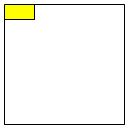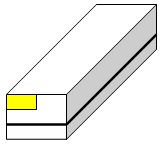Barcode Placement Guidelines for Library and Archival Collections
 |
The barcode is a Schnabel label that will link the item to a bibliographic record in the online catalog. It is approximately 2” long by 5/8” wide. |
These guidelines are for barcoding general collections or barcoding protective containers for collection material. Special collection materials should not have barcodes adhered directly to the materials. The Preservation Dept can assist with suggestions on how to associate barcodes with special collection materials.
Barcode wrapper: a loop of polyethylene film that is 2 ½” wide. This loop is fitted snugly to the front cover of the book from head to tail and the barcode label is attached to it, rather than the cover itself.
The Piggyback barcode label is constructed of two layers of adhesive allowing one label to be used twice. It is commonly used for placement of labels on serials prior to and after being bound.
General rule for barcode placement: Barcodes go on the front of the book or box as defined below.
If the placement of the barcode is going to obscure title information, check to see if the information appears elsewhere in the volume; for example, the title page. If the information is elsewhere, place the barcode in the upper left corner allowing the information to be obscured. If the information is not found anywhere else in the volume, photocopy the cover before placing the barcode in the upper left corner. Put the photocopy of the cover in the volume.
|
Container Type |
Recommended Barcode Location |
Comments |
|
|
Bound materials (hard cover) |
upper left, front corner; closest to the spine. |
 |
Approximately ¼” from the top edge and away from the book joint; books with book jackets see ‘special situations’ at end of this document. |
|
Bound materials (soft cover) |
upper left, front corner; closest to the spine. |
 |
East Asian, Middle Eastern and Judaic materials—please see ‘special situations’ at end of this document. |
|
Serials to be bound |
inside back cover of last issue |  |
Piggy back labels only—see ‘special situations’ at the end of this document. |
| 4-flap folder/portfolio/East Asian wrappers | upper left, front corner; closest to the spine |
 |
See general rule for barcode placement with regards to obscuring titling information. |
| Phase box/Drop spine boxes | upper left, front corner; closest to the spine |
 |
|
| Envelopes | upper left, front corner |
 |
Flap is considered the back of the envelope. The barcode goes on the front. |
| CD & DVD jewel case | upper left, front corner |
 |
Place barcode so it is fully on that portion of the case cover that opens. |
| CD&DVD commercial rectangular case | upper left, front corner; closest to the spine of the case |
 |
|
| Floppy disk jewel case | upper left, front corner |
 |
Place barcode so it is fully on that portion of the case cover that opens. |
| Audio cassettes cases | front, top (short end); closest to the spine |
 |
|
| Audio disks (LP album covers) | upper left corner |  |
|
| Audio disks (45 rpm—7” disks—original jackets, sleeves, acid-free envelopes) | upper left corner |  |
|
| Audio disks (78 rpm—10”x 12”& 16” disks—acid-free envelopes; some original jackets & set boxes | upper left corner |  |
|
| All open audio reels stored in boxes (stored on edge) | upper left edge of box |  |
|
| Video cassettes cases | upper left corner; closest to the spine |
 |
|
| All open reel film in cans (stored on edge) | on the edge | ||
| Microfilm boxes | on the narrow flap |  |
|
| Fiche boxes | narrow end; upper left corner |
 |
|
| Document cases / manuscript/Hollinger boxes (legal or letter size, 5” or 3” wide) readex microcard box | top left corner of narrow end |  |
|
| Paige/record cartons | short side; upper left, below the cover |
 |
|
| Flat box/pizza box Other terms used to describe such a box: clamshell, telescoping, newspaper. These are stored flat on shelf. |
upper left; short side |
 |
|
| Oversize folders Stored in flat files. | lower left corner of open edge |  |
|
| Card file boxes | narrow end; upper left corner |
 |
|
| Map tubes—4x4 square | upper left of long side |  |
|
| Expanding folders | upper left corner |  |
This is for letter or legal size expanding folders. Flap is considered the back of the envelope. The barcode goes on the front. |
Special Situations for barcode placement
Hardcover Books with book jackets:
If the book jacket is being retained, please do not place the barcode directly on the jacket. There are two options: The first is to use a Barcode Wrapper as described on page 1. The other is to create a clear polypropylene book jacket using the CoLibri commercial system. The Preservation Department can assist with either option. Contact the Preservation Field Services Office for assistance.
East Asian, Near East and Judaic materials:
This refers to those volumes whose title page is such that the spine is on the right when opened to the title page. Ignore what is considered the ‘front’ of these volumes. The bar code should be placed on the upper left corner closest to the spine with the spine on the left.
Library Binding Serials:
When bringing issues together to be sent for binding a piggyback barcode is used. The piggyback barcode is placed on the inside back cover of the last issue. After the item is bound the barcode is moved to the upper left of the front cover.